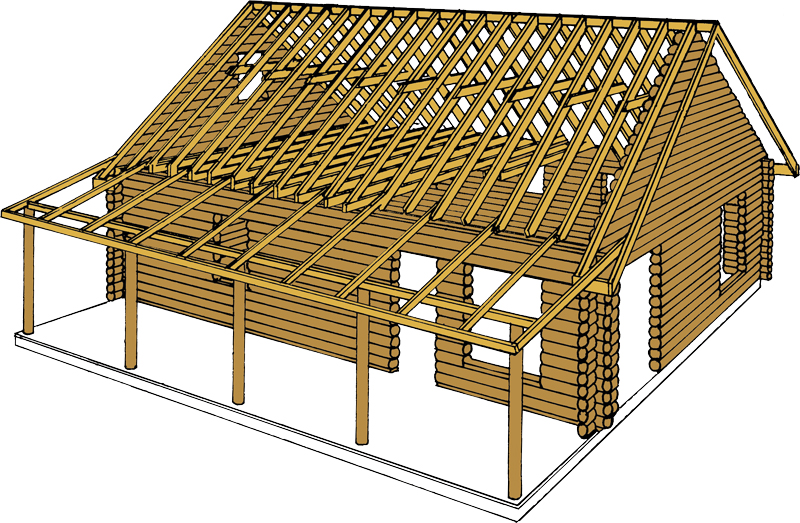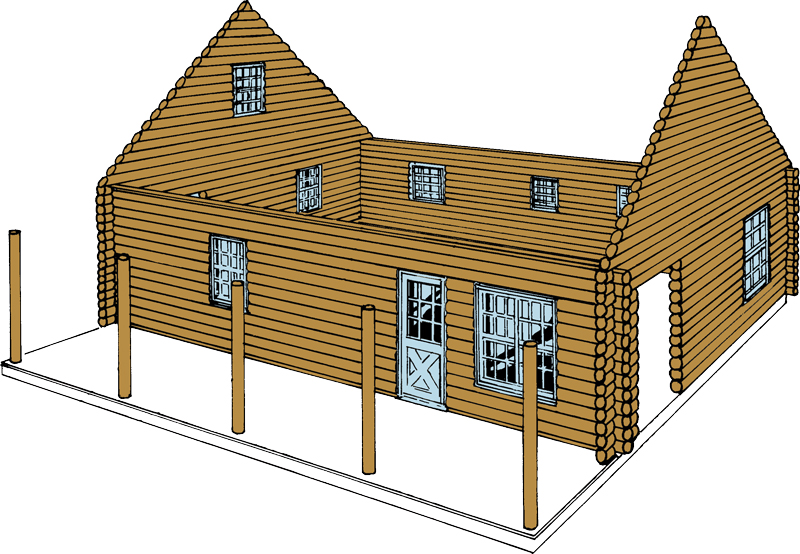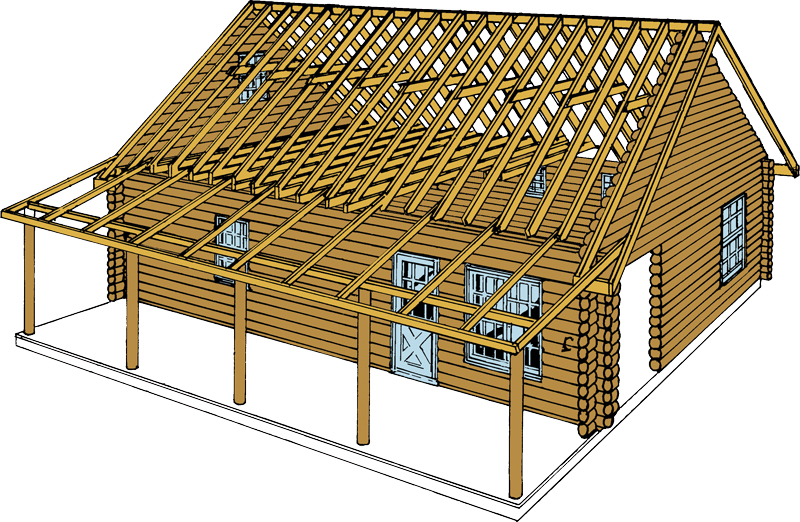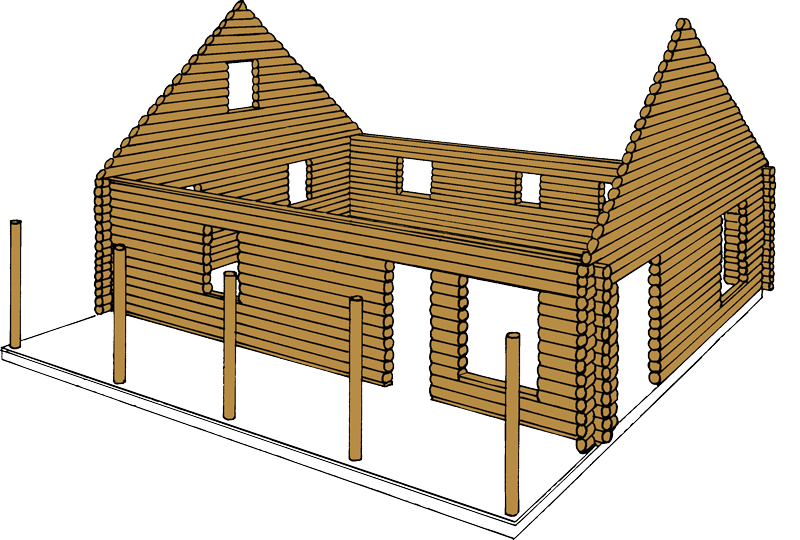
The “package,” (sometimes referred to as the “kit”) is the starting point of log homes for obvious reasons — it contains the logs. Logs are the bulk of the building materials used in log homes, rivaled only by stone and, in some cases, glass. So when you’re selecting a package from a log home producer, you’re buying the majority of the structural components that will comprise your log home. The two most important things to remember about the package are what it contains and what it doesn’t contain.
The distinction is important because all log packages are not the same. This fact is perhaps the most perplexing aspect of buying a log home. Some packages only contain the logs themselves; other manufacturers include much more than merely the wood. Packages vary because customers’ needs, preferences, budgets and time frames vary and because log home producers have different philosophies about how to best serve their customers. Your circumstances will guide you toward choosing the right package and producer for you.
Package Contents
So what’s in a package? There are three primary types of material packages:
Walls-Only
This basic package contains logs for the exterior walls, as well as the fastening and sealing materials needed to erect them. It does not contain a roof system. Since this isn’t a complete structure, the producer is required to make very few engineering or design calculations. The package may or may not contain windows and doors, and the logs may or may not be pre-cut. This type of package has the lowest initial cost, but when the roof structure and other components are added, the home’s final cost may not be the lowest.
Structural Shell
This package should contain everything found in the walls-only package, plus materials for a complete roof system, the exterior doors and windows, including hardware and anything else required to build a weathertight exterior shell. Since this kit will constitute a complete structure, the producer should have designed it to comply with your site’s local building codes. Documentation for this engineering and design work should be available to you so you can obtain a building permit. Again, the logs may be pre-cut or not.
Complete
This third type of package should contain everything found in a structural-shell package, plus most of the other building materials for a complete floor system, interior stud partitions, stairs, doors, hardware and interior wall paneling. Once again, the logs may or may not be pre-cut.
What About Windows and Doors?
Windows and doors are two potentially high-cost items, and log home manufacturers fall into two camps regarding whether to include these components in their packages. Some don’t supply either. They feel that most of their customers can buy windows and doors cheaper locally, especially by shopping for advertised specials.
Other producers, particularly those that sell complete, pre-cut packages, recommend you purchase their windows and doors from them because they often modify the window and door jambs to fit precisely into the pre-cut openings in the log walls. These producers feel this approach provides greater assurance that you’ll have a weathertight seal around windows and doors. A good rule of thumb is to buy windows and doors as part of the package when they are offered, if the producer’s price is comparable to cost of purchasing the same product-quality level at a local retailer.
Comparing Costs
Once you’ve accounted for differences in package contents and log pre-cutting, you can begin to compare costs by looking at each producer’s list of materials. You cannot obtain an accurate cost comparison, however, until you’ve decided the scope of the home you intend to build. Trying to compare the costs of different sizes and styles of homes produced by different companies that include different materials in their packages is an exercise in futility. And remember: Shopping around a producer’s floor plans to other companies is illegal.
To compare costs, develop your specifications. Next, ask producers to show you their lists of materials, accounting for every item they include with their packages and associated costs. Then compare these lists to see what they contain in common and what some producers include that others don’t. Once you know which materials are not included in each package, you can identify the components you’ll have to buy yourself to complete your home.
By adding the cost of locally bought items to the cost of materials supplied, you’re in a position to compare costs on an apples-to-apples basis. If you are planning to erect your own log package or act as your own general contractor, package price comparisons can be tricky.
First, make sure each quote has a detailed materials list attached. You must know exactly what each company is offering. A good book on carpentry (not just log home building) is invaluable because it can illustrate and explain terminology in the lists that may be unfamiliar to you. Break the material list into sections.
Then set up a chart with sections and individual items in a column and names of the kits you want to compare in a row across the top. Next to each item, note whether it is included in the package. If it isn’t, ask the manufacturer if that item will be necessary or desirable to complete the house.
Then call a local supplier to get an estimate on it. Place that cost figure into your quote comparison. You can omit items beyond the scope of any of the kits (plumbing or light fixtures, for example). You may still have trouble comparing exact materials lists because of differences in various producers’ building systems. For example, one package may contain a pre-fabricated roof-truss system, while another offers an exposed beam ceiling with ridge beam and log rafters.
Both constitute a complete roof system, but the exposed rafter-and-beam roof costs much more to produce. There is yet another option: turnkey log homes. If your objective is a turnkey house (one that will be completely erected and finished by a professional builder), comparing package options and prices may be less relevant.
What the turnkey shopper needs to compare is the bottom-line price of the finished house. You can figure this by taking the price of the package with blueprints and material lists to the builders you are considering. They will provide a turnkey quote that includes all the work that you specify. All you need do is compare turnkey bids.

The Handcrafted Perspective
Although packages are associated with log home manufacturers, in a sense, handcrafters supply packages, too. The nature of their contents and services differ, though. The most noticeable disparity results from the fact that after the logs are cut, handcrafters erect the structures in their yard to ensure the tapered logs fit properly and that the walls are level. (Some manufacturers do this as well, though it’s typically not as vital as it is to handcrafting.)
The logs are then marked for reference, disassembled and shipped to the site. The handcrafter generally stays onsite only until the shell is re-erected. Unlike manufacturers, who can supply nearly all the materials required to finish the structure, handcrafters usually provide only the logs and not windows, doors or any of the dimensional lumber needed for floors or roof systems.
You can contract with a local builder to have the finishing work done or, if you have the know-how and inclination, do it yourself. As with manufactured material packages, you need to know exactly what materials the handcrafted package contains. Some handcrafters will serve as general contractors and completely build the home, especially if their yard is near the job site. Others who aren’t equipped to provide construction services may be able to refer you to reputable contractors in your area.
Sample Log Packages
Most log home companies sell material packages that contain the wall logs and other components. Packages are sold in varying degrees of completion, which affect their cost. Here are some common options.
Making the Grade
How do you know the log package you buy is sturdy and strong? Building codes mandate that timber used for residential construction (ALL construction — not just log homes) must be graded, i.e., each piece of wood is examined for acceptable slope of grain, straightness, knot frequency and density and other attributes that could cause it to be structurally inferior (it does not take appearance into account). The National Association of Home Builders’ Log and Timber Homes Council (loghomes.org) and Timber Products Inspection (tpinspection.com) are two third-party agencies that ensure timbers are properly graded for log home construction. Make sure the manufacturer you choose complies.















